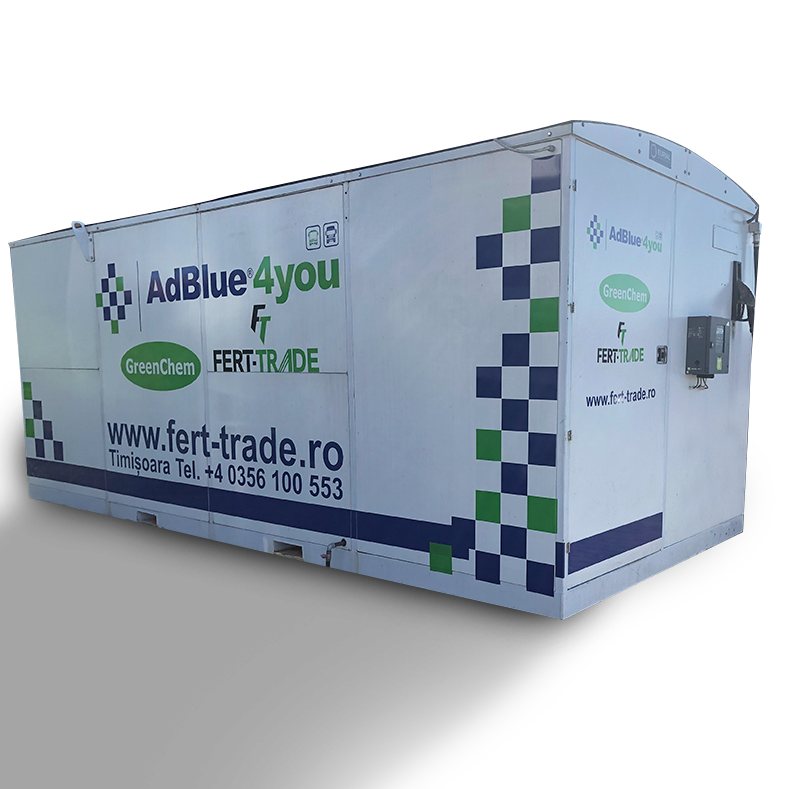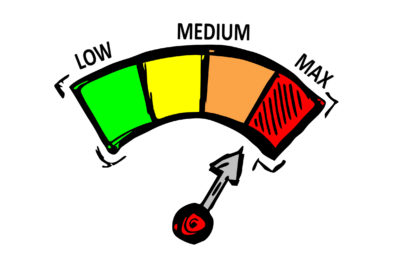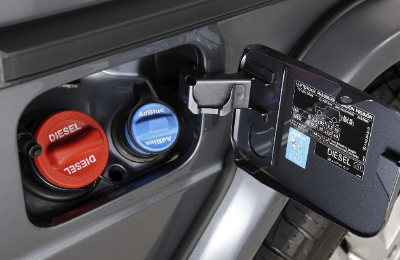
What is AdBlue®?
AdBlue® is a highly purified colourless liquid. It contains demineralized water and urea (32.5%). It is used with diesel engines and is also known outside of Europe as DEF, ARLA 32 or AUS 32 in some countries.
The main active component of AdBlue® is ammonia. This is chemically formed by hydrolysing automotive urea, which is the main raw material for AdBlue®. Urea is also used in the production of fertilizers and many more applications.


AdBlue®
AdBlue® is used with diesel engines using SCR technology. This technology (Selective Catalytic Reduction) reduces harmful emissions (NOx). AdBlue® is injected into the catalyst of the SCR system, where it triggers a chemical reaction with the ammonia. This chemical reaction converts the toxic nitrogen oxides (NOx) into nitrogen (N2) and water vapour (H2O). Water vapour and nitrogen are naturally occurring gasses that are harmless to the environment
AdBlue® is mandatory in Diesel cars since the 1st of January 2017. If your car is less than 2 years old and is a Diesel car, then yes you might need to add some AdBlue® in it!
To make sure this is the case, you simply have to check your user manual.
You can also check AdBlue consumption according to your car model here.
No, Adblue® is not a hazardous substance. It has no known significant effects or critical hazards.
AdBlue® is a highly purified colourless liquid. It contains demineralized water and urea (32.5%). The raw material, urea, even occurs naturally in our digestive system. However, we strongly dissuade you to ingest AdBlue® or inhale it’s vapours, due to the risk of an allergic reaction.
AdBlue® is corrosive and can dissolve materials that are not listed as AdBlue® proof in ISO 22241. These materials could create malfunctions in your SCR-catalyst.
Your AdBlue® consumption depends on your type of operation. A full tank of AdBlue® will last several tanks of diesel.
Estimated usage for trucks:
The average use of AdBlue® vs diesel for tucks is 4 to 8%.
- Local distribution:
– Approximately 500L in one year - National distribution:
– Approximately 1,000L in one year - International distribution:
– Approximately 2,500L in one year

Estimated usage for Passenger cars:
- Mid-class diesel (For example Opel Insignia or Peugeot 508): 1 litre AdBlue® for 1,000 km
- SUV/MPV class diesel (for example Opel Zafira or VW Touran): 1.5 litre AdBlue® for 1,000 km
Check out estimated usage and our suggestion for your car by clicking here
Estimated usage for off-road vehicles:
Because of the wide variety of off-road vehicles, it is difficult to pinpoint their exact usage. A large heavy duty tractor can use 2,500L of AdBlue® a year.
A ratio of 5 to 10% of the diesel usage is used to calculate the required AdBlue®.
AdBlue® should be stored out of direct sunlight between -6°C and 25°C in a clean and sealed container or dispensing unit. Storing it in the wrong equipment may result in costly damage to your vehicle due to contamination, which can result in SCR-catalyst replacement and downtime.
Storage Requirements
Environment:
Check local legislation for environmental requirements. Some countries require a bunted AdBlue® storage tank when you are storing AdBlue® or an anti-spill container under the IBC or drums. Contact local authorities for further information on storage requirements.
AdBlue® Suitable materials:
AdBlue® can only be stored in high-density Polyethylene, polypropylene or stainless steel containers. Suitable materials for piping, insulation and sealing:
- Polyisobutylene (synthetic rubber), free of additives – (for seals and hoses)
- PFA, PVDF & PTFE (Teflon) free of additives (for sheet – lining for chemical equipment/support rings, seals)
- Copolymers of (P)VDF and HFP (Viton), free of additives – (for the insulation of electrical wires & seals/o-rings)
Do not use corrosive materials like copper, nickel, zinc, mild iron or aluminium. You can check the entire list in the ISO 22241 recommendations.
All materials used by GreenChem meet the AdBlue® requirements and all experience gained since the start of AdBlue® are implemented in the GreenChem AdBlue® products and available for you.
No, unfortunately filling your car up with AdBlue® at a pump is not possible yet. The pumps of AdBlue® at gas stations are available for trucks only and are not suited for filling up cars. We are now developing solutions to meet this new demand, and we will be pleased to inform you once this is ready to go.
The network of AdBlue® distribution for cars is in an early developing stage, however, many gas stations do sell AdBlue® in canisters and we will be very happy to help you find the closest station by using our Smartphone App on iTunes and at Google Play
If you find that you have accidentally put diesel in your AdBlue tank then Do not start your engine!Diesel contaminates the AdBlue® and any contamination may cause costly damage to your SCR-system. It is best to contact your vehicle manufacturer to prevent any damage to your car. You may have to replace certain AdBlue® components.
Your vehicle needs AdBlue® to reduce NOₓ emission. Due to the stricter emission legislation, diesel engines need to have cleaner exhaust gases. NOₓ is one of the emissions that causes acid rain. To meet the Euro 6 standards for diesel engine emission the use of Selective Catalyst Reduction-technology (and thus AdBlue®) is required. The Euro 6 standards are into force from September 2014 for new passenger cars.
All commercial vehicle manufacturers have to meet the Euro 6 standards for diesel engine emission. Although Euro 5 emission standards could be met by different technologies, Euro 6 standards require the use of Selective Catalytic Reduction with AdBlue®.
AdBlue® is widely available in 10 and 20 lit. cans, 200 lit. drums and 1000 lit. Intermediate Bulk containers (IBC’s) or via designated AdBlue® dispensing systems.
Most truck stops already sell AdBlue® in cans or bulk. Europe also has a widespread network of AdBlue® distributors and commercial suppliers. Look for dispensing units with the AdBlue® logo and fill your tank just as you would tank fuel.
You can recognise your AdBlue® tank by its blue cap or an AdBlue® label, but it is a totally separate tank.
The filling point is often fitted near your diesel cap. Some passenger cars have an AdBlue® tank in the boot or in the engine bay.
The opening for your AdBlue® tank is narrower than the opening for a diesel tank, so you should not be able to put diesel in the wrong tank (the nozzle does not fit).

What do I do when I have spilled AdBlue®?
AdBlue® is not dangerous to the environment. A small AdBlue® spill can be diluted with water. It is best to mop up the spillage and avoid flushing it down a drain or waterway.
In case of a large spill, try to prevent the spillage from entering drains or waterways. Contain the spill with sand, earth or your spill kit and dispose of it properly. Spill kits are available in different sizes and sets.
Note: The surface on which you spill AdBlue® may become slippery. Make sure that you clean up the spill as quickly as possible to prevent slipping and falling.
Can I reuse spilled AdBlue®?
No, never try to reuse spilled AdBlue®!
Spilled AdBlue® will always be contaminated. Using contaminated AdBlue® can cause costly damage to your vehicles’ SCR system, so no matter how great the spill, you cannot reuse it!
No, the engine will not shut down, but some engines automatically limit engine performance when AdBlue® supplies are depleted.
If your engine is equipped with SCR technology, your vehicle will lose power and reduce its emission according to legal standards. The vehicle’s performance will be restored when AdBlue® levels are up again.
Note: Some engines will not start after you have run out of AdBlue®. Make sure that you have an emergency supply on board, or continue to the next distribution point without shutting down your engine.
If you want AdBlue® for your passenger car, you can know download our APP from iTunes or Google Play by clicking on them.
Your car will warn you when the range for the AdBlue® tank is 2400 km. What happens after the 2400 km warning is different for each brand, so please check your owner’s manual to find out what applies to your vehicle.
For example, a Opel Zafira Tourer will warn you at a range of 2400 km. Then, the car will limit your maximum speed to 100 km/h at a range of 900 km. The car will eventually limit the maximum speed to 50 km/h and it will warn you that the engine will not restart once the engine is turned off.
Make sure you carry an emergency supply on board or continue to the next distribution point without shutting down your engine.

